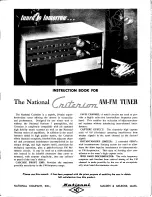
WiNRADiO G65DDC User’s Guide
20
As a useful parallel, the demodulator spectrum can be compared to the IF
spectrum of a conventional receiver.
The dark blue rectangular area inside the DDC1 spectrum corresponds to the
demodulator bandwidth, while the gray area inside both the DDC1 and
demodulator spectrums relate to the demodulator filter bandwidth. This
bandwidth represents the selectivity bandwidth of the receiver… and for the
best signal-to-noise ratio of the received signal, you might wish to adjust this
bandwidth to very closely embrace the visible spectrum of the received signal.
You can do this either by using the
DEM BW
control, or by dragging the edges
of the gray area in the demodulator spectrum.
You can also drag the gray areas sideways, by clicking and dragging at their
center or anywhere inside them, in both the DDC1 and demodulator spectrum.
This is equivalent to the
IF Shift
function of conventional receivers.
Clicking on any of the three spectrum scopes will cause the receiver to tune to
the corresponding frequency. But as the WiNRADiO Excalibur Sigma consists
of three receivers in one, this does have some ramifications which will be
further explained in the following chapters.
The receiver also features optional external 10 MHz reference input/outputs
and coherence mode of operation, also a 1 PPS pulse input and an FPGA
interface.
Please don’t forget to register as a WiNRADiO user to receive news about new
products, accessories and software upgrades for your Excalibur receiver. Use
our on-line registration form at
www.winradio.com/register
to take advantage
of this free service.
















































